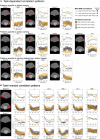The relationship between electrophysiological and hemodynamic measures of neural activity varies across picture naming tasks: A multimodal magnetoencephalography-functional magnetic resonance imaging study
- PMID: 36408411
- PMCID: PMC9669574
- DOI: 10.3389/fnins.2022.1019572
The relationship between electrophysiological and hemodynamic measures of neural activity varies across picture naming tasks: A multimodal magnetoencephalography-functional magnetic resonance imaging study
Abstract
Different neuroimaging methods can yield different views of task-dependent neural engagement. Studies examining the relationship between electromagnetic and hemodynamic measures have revealed correlated patterns across brain regions but the role of the applied stimulation or experimental tasks in these correlation patterns is still poorly understood. Here, we evaluated the across-tasks variability of MEG-fMRI relationship using data recorded during three distinct naming tasks (naming objects and actions from action images, and objects from object images), from the same set of participants. Our results demonstrate that the MEG-fMRI correlation pattern varies according to the performed task, and that this variability shows distinct spectral profiles across brain regions. Notably, analysis of the MEG data alone did not reveal modulations across the examined tasks in the time-frequency windows emerging from the MEG-fMRI correlation analysis. Our results suggest that the electromagnetic-hemodynamic correlation could serve as a more sensitive proxy for task-dependent neural engagement in cognitive tasks than isolated within-modality measures.
Keywords: MEG; clustering; correlation patterns; data fusion; fMRI; multimodal data; picture naming.
Copyright © 2022 Mononen, Kujala, Liljeström, Leppäaho, Kaski and Salmelin.
Conflict of interest statement
The authors declare that the research was conducted in the absence of any commercial or financial relationships that could be construed as a potential conflict of interest.
Figures







Similar articles
-
Task- and stimulus-related cortical networks in language production: Exploring similarity of MEG- and fMRI-derived functional connectivity.Neuroimage. 2015 Oct 15;120:75-87. doi: 10.1016/j.neuroimage.2015.07.017. Epub 2015 Jul 11. Neuroimage. 2015. PMID: 26169324
-
Functional magnetic resonance imaging blood oxygenation level-dependent signal and magnetoencephalography evoked responses yield different neural functionality in reading.J Neurosci. 2011 Jan 19;31(3):1048-58. doi: 10.1523/JNEUROSCI.3113-10.2011. J Neurosci. 2011. PMID: 21248130 Free PMC article.
-
Comparing MEG and fMRI views to naming actions and objects.Hum Brain Mapp. 2009 Jun;30(6):1845-56. doi: 10.1002/hbm.20785. Hum Brain Mapp. 2009. PMID: 19378277 Free PMC article.
-
Which "neural activity" do you mean? fMRI, MEG, oscillations and neurotransmitters.Neuroimage. 2012 Aug 15;62(2):1121-30. doi: 10.1016/j.neuroimage.2012.01.028. Epub 2012 Jan 9. Neuroimage. 2012. PMID: 22248578 Review.
-
Human brain mapping: hemodynamic response and electrophysiology.Clin Neurophysiol. 2008 Apr;119(4):731-43. doi: 10.1016/j.clinph.2007.10.026. Epub 2008 Jan 9. Clin Neurophysiol. 2008. PMID: 18187361 Review.
References
LinkOut - more resources
Full Text Sources

